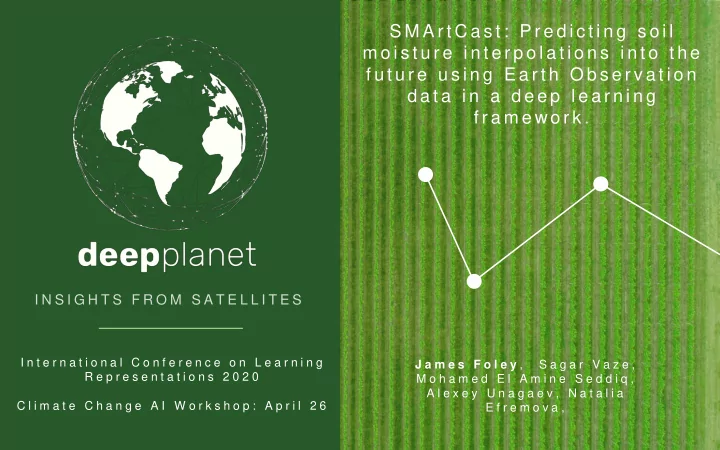

S M A r t C a s t : P r e d i c t i n g s o i l m o i s t u r e i n t e r p o l a t i o n s i n t o t h e f u t u r e u s i n g E a r t h O b s e r v a t i o n d a t a i n a d e e p l e a r n i n g f r a m e wo r k . I N S I G H T S F R O M S A T E L L I T E S I n t e r n a t i o n a l C o n f e r e n c e o n L e a r n i n g J a m e s F o l e y , S a g a r V a z e , R e p r e s e n t a t i o n s 2 0 2 0 M o h a m e d E l A m i n e S e d d i q , A l e x e y U n a g a e v , N a t a l i a C l i m a t e C h a n g e A I W o r k s h o p : A p r i l 2 6 E f r e m o v a ,
Introduction The Problem Climate change will cause a rise in global temperatures but also increase the unpredictability of • weather with more extreme weather events. • Soil moisture is dependent on rainfall and temperature and is a critical component of growth for almost all arable crops globally. • Non optimal soil moistures can lead to lower yield or in extreme cases entire crop loss so many crop growers invest in soil moisture monitoring sensors to help inform their irrigation schemes. • Soil moisture sensors provide soil moisture at one specific area but not across an entire area meaning differences could damage crops unknowingly. However, irrigation can only occur reactively to changes in soil moisture rather than proactive • reduction of harm.
Aims The Problem Soil moisture at sensors can be predicted into the future accurately • • Satellite imagery can be used and also predicted into the future to derive information across an entire area. • Accurate interpolation can be done of soil moisture between the sensors. Deep learning can be used to produce an end to end pipeline of soil moisture prediction across an • entire area.
Methods The Problem Soil moisture as measured at multiple sensor locations across all depths is predicted forward two • weeks into the future using an encoder decoder LSTM . Soil moisture predictions for a single sensor at all depths. Structure of the LSTM encoder decoder model for soil moisture prediction.
Methods The Problem This is then supplemented by using satellite imagery to calculate normalised difference vegetation • index (NDVI) and normalised difference water index (NDWI) across the entire area. • A separate encoder decoder LSTM is used to generate predicted NDVI and NDWI images into the future Structure of the LSTM encoder decoder model for prediction of NDVI time series
Methods The Problem Per pixel NDVI, NDWI and elevation maps are then used with predicted soil moisture at the sensor • locations to interpolate between sensors using a spatial kriging algorithm and create a per pixel prediction of soil moisture across the entire satellite image. Left) Soil moisture interpolation across the satellite image at 10cm depth. Right) the interpolated soil moisture at all depths with each depth stacked on top of each other.
Results The Problem The LSTM predictions of soil moisture perform differently depending on the depth. • Root Mean Squared Error (RMSE) across the 14 days of prediction is highest at shallowest depths decreasing at the lower depths. Model Training Error Testing Error Value Range Soil Moisture 0.1% - 1% 0.4% - 2.4% 15% - 60% LSTM NDVI LSTM 0.027 0.065 0 - 1 NDWI LSTM 0.014 0.02 -0.3 – 0.55
Results The Problem Accuracy varied depending on the depth that was being predicted with kriging scores (a proxy for • accuracy varying between 0 and 1) between 0.82 – 0.97 with and average of 0.93 across all depths. Interpolated soil moisture at all depths bellow 60cm with each depth stacked on top of each other rotating to show entire area.
Discussion The Problem Advanced warnings of non optimal soil moistures across an entire area can help to prevent loss of • crops and reduction of yields. • Accurate predictions of soil moisture can provide crop resilience to growers through the construction of precision irrigation regimes in response to the uncertainty brought about by climate change. • Precision irrigation can be designed to use less water making arable crop growth more sustainable.
www.deepplanet.ai james@deepplanet.ai
Recommend
More recommend